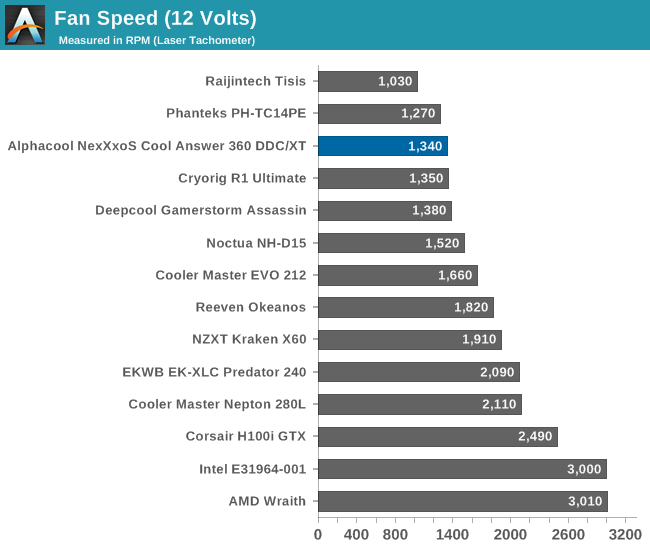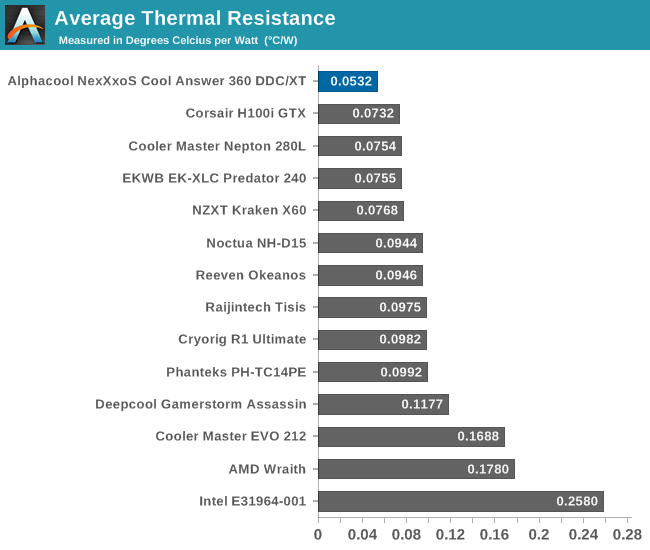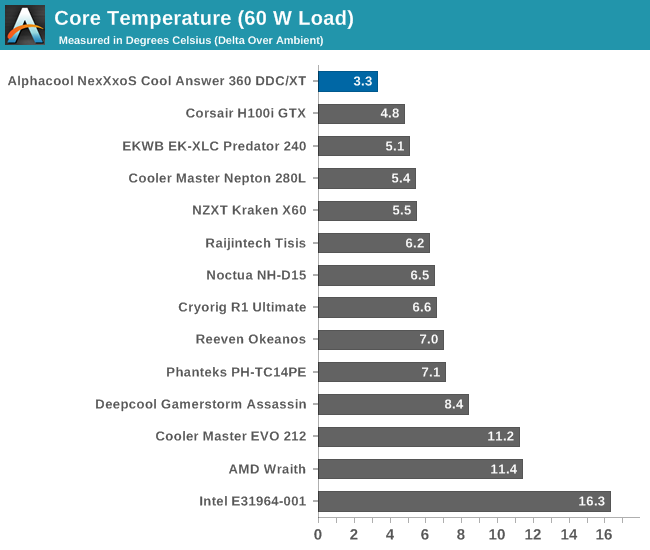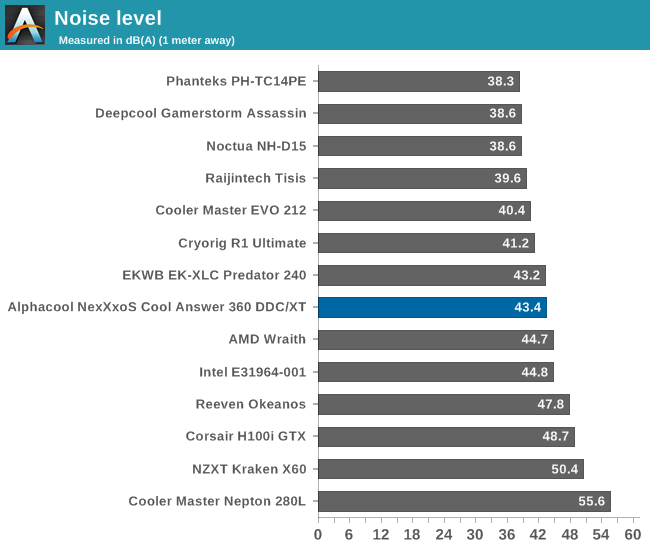The Alphacool NexXxoS Cool Answer 360 DDC/XT Liquid Cooling Kit Review
by E. Fylladitakis on October 24, 2016 9:30 AM ESTTesting Results, Maximum Fan Speed (12 Volts)
The thermal performance of the NexXxoS Cool Answer 360 DDC/XT kit proves that size (and powerfulness) does matter. With its fans and pump at maximum speed, it wipes the floor with the AIO coolers that we have tested up to this date. Top-tier air coolers follow closely behind the AIO liquid coolers. Mainstream and stock air coolers are virtually incomparable against the NexXxoS Cool Answer 360 DDC/XT.


The average thermal resistance of the NexXxoS Cool Answer 360 DDC/XT is 0.0532 °C/W, the best that we have recorder to this date by any cooler, air or liquid based. It remains almost entirely constant regardless of the thermal load, hinting that the system is capable of both quick thermal energy absorption from the CPU and fast dissipation to the environment regardless of the thermal load. In other words, both the pump and the radiator are dramatically oversized for the cooling of a single CPU. The performance of this kit would most likely be only slightly affected, if affected at all, even if a couple of GPU cooling blocks are added to it.

| Core Temperature, Constant Thermal Load (Max Fan Speed) |
With its fans at maximum speed, the NexXxoS Cool Answer 360 DDC/XT produces a sound pressure that measures 43.4 dB(A) from one meter away. This is significantly better than what most AIO coolers that we have tested to this date can achieve, but it would still be uncomfortably loud for the majority of home users and gamers.











40 Comments
View All Comments
saratoga4 - Monday, October 24, 2016 - link
>copper block and a latheCopper block and mill. Lathe is the spinning one that works on pipes, mills are the drill type devices that cut blocks.
And yes, milling my first gpu cooling was pretty annoying. So much nicer these day :)
DanNeely - Monday, October 24, 2016 - link
Having used open loop coolers for the better part of a decade, I'll second that the DDC pump is going to be the loudest part if running at full speed unless you go crazy with fans. (I really wish someone would design a more suitable pump from the ground up instead of just slapping a modified top on the stock model.) However while it's picky about it's operating voltage you can slow and quiet them using PWM control. My current loop has a CPU, Mobo Mosfets, GPU, and a 560 radiator. Using an 4yo Swiftech DDC pump (not sure exact model they've got several of them) I've found that PWMing it to about 70% drops the high pitched pump noise below the noise floor of my low speed fans while only raising core temps by about 1-2C.Oxford Guy - Tuesday, November 8, 2016 - link
The pump in the EK L 2.0 kits is pretty quiet when suspended.Andrew LB - Wednesday, February 8, 2017 - link
I'm surprised they didn't use a pump like the DDC-1T PWM which is a 10w version that does 420l/h and is pretty much silent. I have one in my PC and even with an XSPC Raystorm V3 CPU block, Aquacomputer Krygraphics GTX 780ti full block, XSPC ex360 and ex280 radiators, and quite a few 90' and 45' XSPC rotary fittings, my DDC-1T PWM has a flow rate of 0.91gpm according to my Aquacomputer Aquaero with high-flow meter.Aerodrifting - Monday, October 24, 2016 - link
The part which the pump connects to the reservoir really concerns me. From the looks of it, It's just the barbs that come with DDC stock top (which we usually replace with custom ones to fit standard fittings plus better flow) go straight into the opening of the reservoir without any tightening measures. Are you sure that is not going to leak?BrokenCrayons - Monday, October 24, 2016 - link
The benchmark results are pretty impressive, but hardly worth the risk of mixing liquid with electricity or the added cost over just using the manufactuerer certified heatsink and fan that comes in the box with the CPU. So the processor runs at 40 degrees instead of 70. That's utterly meaningless to me when the max temp for a chip is typically +90 degrees and certainly not worth any additional cost at all much less a cost that includes the problem of pumping fluids around a system that works perfectly well with circulating air.Death666Angel - Monday, October 24, 2016 - link
It's a hobby. It can have some benefits, but it's a hobby first and foremost in my opinion. Yes, I could overclock my CPU and GPU some more while under water, it has a bit less noise and it can be more versatile. But modern aircooling is also pretty good, usually cheaper and not that much louder if you select good components. Though I will always spend a bit more to get a better cooler compared to the boxed offerings (headroom in the summer, dust buildup, better overclocking, quieter operations). But it depends on your setup and taste. :)BrokenCrayons - Monday, October 24, 2016 - link
That I can understand. Everyone has something they waste time and money on just for fun, but I don't think there's a practical reason behind it. I leave my desktop computer with it's 95W 860K CPU sitting in the mud room (no AC...basically my front porch) and run it headlessly to stream games. It spent the summer in ambient temps of around 80-85 degrees streaming games via Steam and the entire time it was and still is on the pre-Wraith HSF that came in the box with the CPU.Sure, I thought about replacing the cooler with something non-OEM or even getting a Wraith second hand from ebay or something, but there's absolutely no reason to do so. I can't rationalize spending even a minimal amount of money on it and then going through the trouble of opening the case up to replace the HSF. I might clean the dust bunnies out next spring, but at this point any additional cooling would serve no practical purpose.
letmepicyou - Monday, October 24, 2016 - link
There is a VERY practical purpose to water cooling which you're missing. If you've ever used a high end air cooler (and I have a cupboard full of them, up to the top shelf Thermalright Silver Arrow) then you know that they're HEAVY. This isn't a problem if your computer sits at your desk until cleaning time or your next upgrade cycle. I can promise you that having a huge cooler on your motherboard can be precarious if you tend to lug your PC around at all. You have to be pretty ginger with your movements.The reason I went to water cooling is now when I lug my PC around, I don't have to worry about component stresses. Given that I have a nice AIO loop on my CPU and run all SSDs, I could boot kick my tower and not worry about data loss or yanking the mounting post for my air cooler through the fiberglass of my motherboard.
BrokenCrayons - Tuesday, October 25, 2016 - link
Actually, my argument is in favor of OEM-boxed coolers that ship in retail packaging with the CPU. Those have never been too heavy for the mounting mechanisms that support them. The situation of an overweight air cooler is a self-inflicted wound that wouldn't have required the proverbial medical attention of liquid cooling had the person in question never picked up the overweight air cooler knife to begin with.